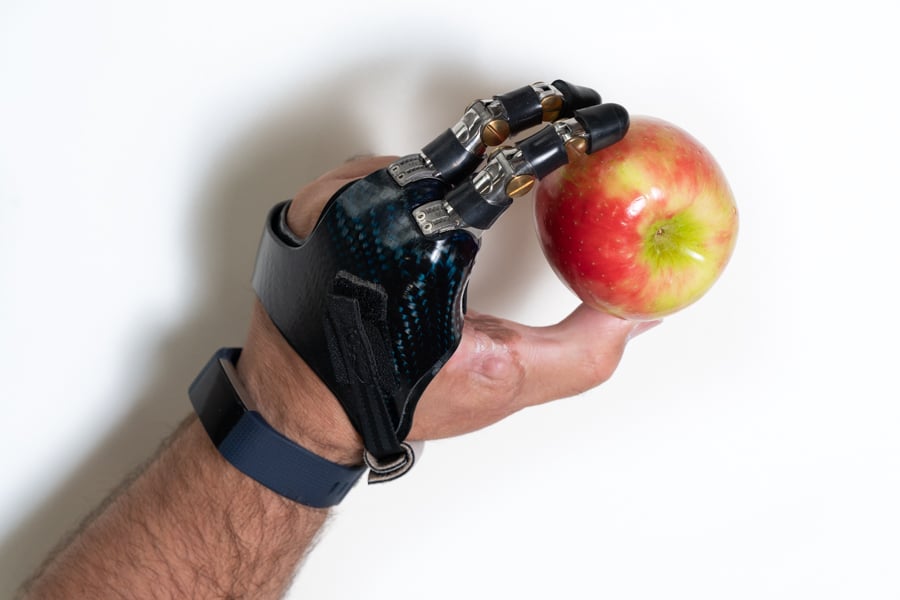“To each their own” is a phrase that applies well to individuals who wear prosthetic devices. There are many different types of terminal devices that provide excellent function for the person using them. In this article, we’ll discuss the benefits of using passive devices and passive silicone restorations.
Let’s start with the mental health aspect of it. Passive devices can be some of the least expensive prosthetic options, making them accessible to more people. We have heard from many of our patients with acquired amputations that the benefits of looking down and seeing a hand there, even if it is a passive silicone restoration, can be enormous. It helps them cope with the loss of their hand. When someone is able to wear a passive device or custom silicone restoration, it can save them from what many people who don’t wear a device do: put their affected hand/limb in their pocket or hide it behind their back. This guarding/maladaptive behavior can contribute to feelings of embarrassment, and also cause overuse issues with the other hand and arm.
With the natural appearance of a custom silicone restoration, the wearer doesn’t have to worry that others will see them as different. These devices can do an excellent job of keeping gawkers at bay because strangers won’t see a prosthetic device — at a casual glance they just see another arm. We have an excellent example of a patient who didn’t think he wanted a custom silicone restoraiton at first. After Abe’s amputation, he initially opted to wear a body-powered hook and a TASKA hand. But after repeatedly getting stopped by inquisitive flyers at the airport, and at least one ruined dinner with his wife due to an overly curious waitress, Abe decided that a custom silicone restoration hand might help him blend in — Abe's tattooed custom silicone restoration is below:
Both passive devices and custom silicone restorations also do an excellent job of protecting the residual limb. Many people with an acquired amputation experience sensitivity at the end of their residual limb due to neuromas or other issues. The prosthesis can act as a cushion between the residual limb and the harsh outside world.
These devices are more functional than one might think. Both custom silicone restorations and passive devices provide a surface for stabilizing and may allow people to use both hands to pick up bulky items. Some custom silicone restorations may include passive wire armatures that allow a small amount of positioning ability, so the patient can change their grip with their sound hand to hold a variety of objects. Passive positionable devices, such as Point Designs, which you can see in the image below, can provide grips and up to a 150 pound load rating.They may also help balance out a person’s body and minimize overuse issues on their sound side.
In addition, passive devices have some advantages over other types of prostheses. While multi-articulating myoelectric hands might look cool, not everyone wants that bionic look. Most electric devices aren’t particularly durable or waterproof, and they need to be plugged in each night. Body-powered devices can require a harness, which bothers some people. A custom silicone restoration or passive device needs less maintenance than either of those options while still providing functionality for the patient — and they’re waterproof!
But just because they are simple devices doesn’t mean that our prosthetists fit our patients and then send them out the door. Our clinical therapy specialists work with each individual to make sure they know how to use and care for their device. Our holistic approach to prosthetic care means we employ screening tools like our Wellness Inventory (WI). Our WI screens our patients in key psychosocial areas: resilience, pain, post-traumatic anxiety, drug and alcohol use, health-related quality of life, and depression.
According to our associate, clinical psychologist and amputee Suzi Phelps, Ph.D., “Addressing psychosocial challenges could be the difference between a person having the patience and motivation to learn how to use their prosthesis or becoming frustrated and giving up."
If you or someone you know may benefit from a passive prosthesis or custom silicone restoration, please contact us. If you use or have used a passive device and would like to tell others about your experience, please comment below. We hope you have found this article helpful.







%20President%20and%20Senior%20Clinical%20Director.jpg?width=600&height=600&name=John%20M.%20Miguelez%2c%20CP%2c%20FAAOP(D)%20President%20and%20Senior%20Clinical%20Director.jpg)










Comments (2)